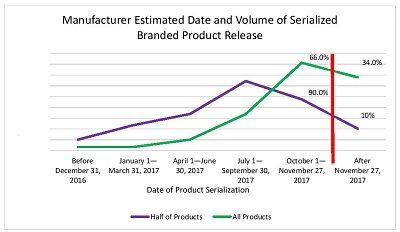Traceability readiness survey: one third of pharma suppliers will not be ready by November 2017
HDA survey raises question: what then?
In conjunction with its annual Traceability Seminar (Washington, DC; Nov. 10-11) the Healthcare Distribution Alliance unveiled a fairly rigorous, third-party-managed survey of drug suppliers impacted by the Drug Supply Chain Security Act (DSCSA), which, as part of a 10-year timetable, has a deadline of November 2017 for individual pharmaceutical packages to be uniquely identified by a serial code. This code, in turn, will provide the means to track pharma shipments from point of manufacture to point of dispensing (pharmacies and hospitals), which is set to be fully implemented by November 2023.
The survey results are a good example of glass-half-full, glass-half-empty. On the one hand, 89% of respondents will have at least some of their products serialized by November 2017. On the other, only 66% of branded manufacturers (see figure), and 67% of generic manufacturers, expect to have 100% of their products ready by then. Putting a brave front on the results, HDA says that manufacturers “manufacturers are working diligently to serialize products by the November … milestone.”
Two-thirds of branded manufacturers will have all their products serialized by the November 2017 deadline

In theory, FDA could shut off distribution of any unserialized product on Nov. 28 of next year—but that won’t happen. An earlier set of deadlines, for manufacturers and other supply chain participants to be processing lot-level product data starting in January 2015, was postponed for five months, with FDA saying it would use “regulatory discretion” in enforcing DSCSA law. And the reality—which has dogged pharma industry traceability efforts for over a decade now—is that a needed medication for a patient won’t be held up by more precise identification requirements by FDA.
The picture could be even less bright based on the survey’s base of respondents. HDA used “all manufacturer contacts” in its own database, which probably represents several hundred companies. Seventy-three companies responded, which HDA says “represents 71% of stockkeeping units” in circulation in the US (which HDA knows very well, since SKU counts are the basic information HDA wholesaler/distributor members live by). But HDA members do not account for 100% of pharmaceutical distribution, and the companies that represent the other 29% of SKUs, who didn’t respond to the survey, are less likely to be streaming forward with their serialization efforts. (To get really granular on this point: the Drugs.com website lists about 360 pharma companies with commercial products in distribution; and the industry is dependent on dozens of contract manufacturers [CMOs] and packagers who also are impacted by elements of DSCSA. Then there is another set of repackagers who are also impacted.)
The HDA survey also asked about industry expectations for aggregation, the proposed method of tying the serial numbers of individual packages to the case or pallet they’re shipped in, which obviates the need to reopen each case and manually check serial numbers (which, in turn, would clobber the operational efficiencies of conventional distribution.) Roughly a third of respondents say they will aggregate by November 2017; a third will do so by 2023; 26% say they are unsure and awaiting FDA guidance; and 5.5% say that they will not. Lack of FDA guidance on this and other DSCSA topics is the No. 1 reason (tied with CMO readiness) that 40% of respondents said they had “concerns” about DSCSA readiness by November 2017.
Industry blogger Dirk Rodgers, at his RxTrace.com site (subscription required) took a flyer in the aftermath of the Presidential election by asking “Will President Trump eliminate the DSCSA?” as part of an overall retrenchment of healthcare policies and regulations, but that’s pure speculation at this point, and the fact of the matter is that any manufacturer involved in international trade will need to serialize products to meet country requirements in much of the world. Corporate business strategists are already looking at the potential value of comprehensive tracking data in pharma distribution, as are healthcare providers seeking to improve patient safety.